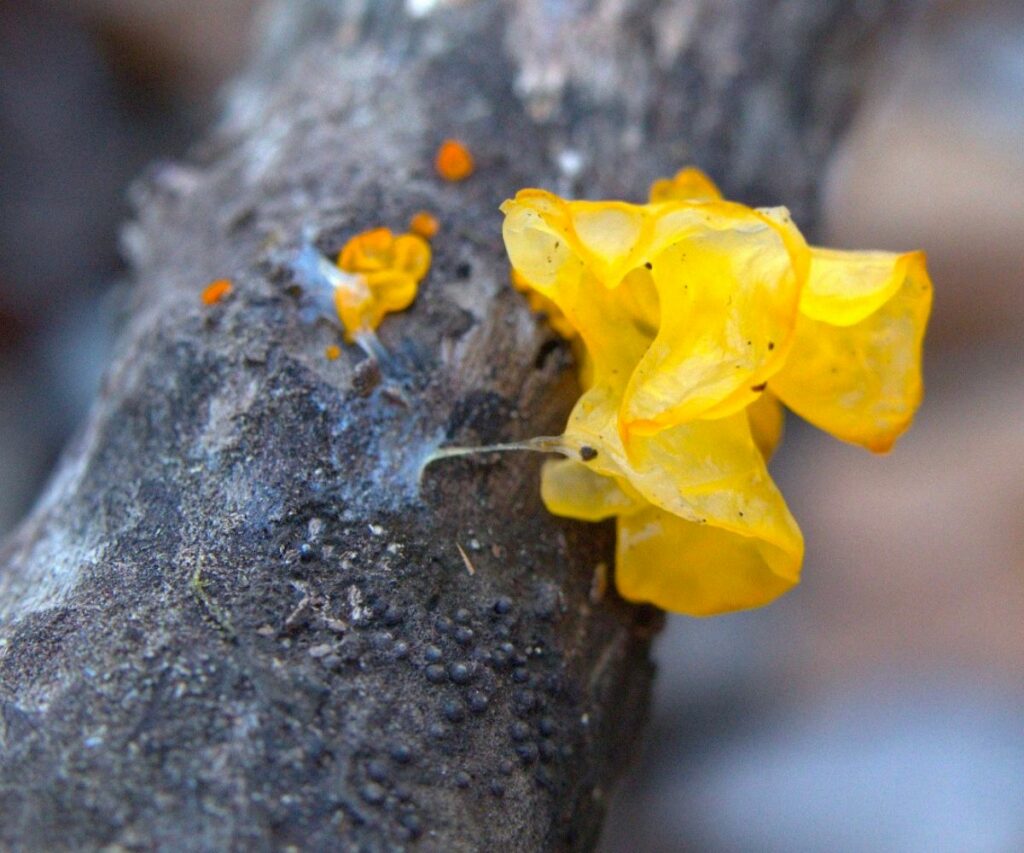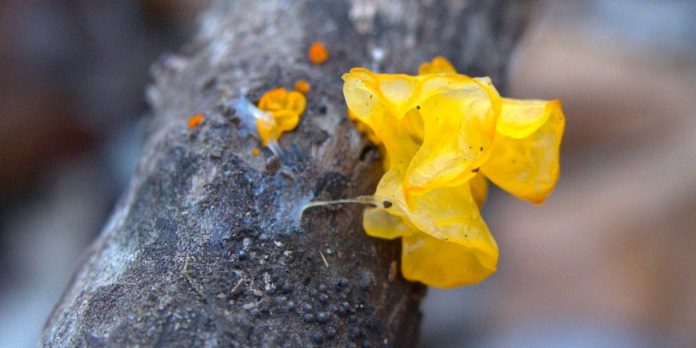Witches’ butter might just cast a love spell on you.
This fantastic fungus fruits year-round, providing an incredibly versatile resource to foragers, homesteaders, and survivalists worldwide.
So, what exactly can you do with it?
Read on to discover 12 surprising witches’ butter uses, from culinary to medicinal and everything in between.
Which Witches’ Butter?

Let’s clear something up before we begin.
The nickname “witches’ butter” may refer to a number of jelly fungi from the families Auriculariaceae, Dacrymycetaceae, and Tremellaceae.
Learn how to identify witches’ butter.
With so many different varieties, how can we be sure they all offer the same benefits?
Well, we can’t. They almost certainly don’t since composition varies between species. That’s why they have different appearances, textures, and growth habits. However, some research studies suggest that many of the species (and indeed, the three jelly families) show similar traits on a genomic level.
Taxonomic chaos in the world of the jellies only reinforces their similarities, with individual species often belonging to different families in different parts of the world.
In other words, even the experts are confused.
It’s essential to realize and accept that not every specimen you find will offer the exact same nutritional and medicinal profile. But though they may vary in potency, each species is beneficial and suitable for similar uses.
Top 12 Witches’ Butter Uses and Benefits
1. Immunomodulator
In traditional Chinese medicine, one of the most common witches’ butter uses is as a tonic for the immune system. We have scientific evidence to back this up, with one study demonstrating the mushroom’s impressive effectiveness in treating atopic dermatitis in mice by regulating immune response.
Scientists administered the witches’ butter either topically or orally. Interestingly enough, both pathways yielded positive results, but oral administration proved far more effective. Still, if you’re averse to the flavor of witches’ butter, it’s worth applying it topically to rashes, hives, and other immune-responsive outbreaks. Making a salve or balm would be appropriate here.
Another study of Tremellaceae mushrooms demonstrated that witches’ butter was able to reduce pathological features of immunosuppression in artificially immunosuppressed mice. This means the mushroom can stimulate the immune system in addition to suppressing it, triggering responses based on what the body needs.
2. Antineoplastic
Mushrooms like turkey tail and witches’ butter have an incredibly high polysaccharide yield. The polys are known for their immunomodulatory, antioxidative, and antineoplastic abilities.
In one study, witches’ butter from all three jelly families proved an effective treatment to shrink sarcoma cells and Ehrlich solid tumor growth by 60%–100%.
If consumed regularly, witches’ butter may inhibit tumor growth. It could be an incredibly effective cancer treatment, especially when used in conjunction with pharmaceutical intervention.
3. Neuroprotective
Potentially, one of the best witches’ butter uses is for the prevention and treatment of neurodegenerative diseases like dementia and Alzheimer’s.
This fungus has been tested in cognitively impaired rats and was proven to enhance spatial learning and memory compared to a control group.
While this is promising, human research is even more so, and while it’s sparse, we do have some. In one research study, scientists gave a group of 75 cognitively impaired individuals a placebo and a witches’ butter supplement.
After eight weeks, individuals taking the supplement showed more significant improvement in cognitive function, executive function, and short-term memory. They even had changes in gray matter.
According to the study, as little as 600 mg of witches’ butter daily could positively affect brain health and promote overall brain function.
5. Antimicrobial
The antimicrobial effects of basidiomycete mushrooms have long been established, and witches’ butter seems no exception.
One clinical trial proved that the T. mesenterica species was at least somewhat effective at fighting the gram-positive bacteria H. pylori. It provided significant symptomatic relief both alone and when used in conjunction with regular treatment.
Did the trial prove witches’ butter to be a magic cure? No. Individuals remained infected after 10 days, but their conditions improved.
Perhaps with long-term treatment, witches’ butter could have eradicated the infections entirely. We don’t really know, but it’s definitely worth supplementing with T. mesenterica when you’re feeling ill.
6. Inflammation Fighter
The polysaccharides in yellow witches’ butter fight inflammation and reduce oxidative stress.
The mushroom can slow down physical signs and symptoms of aging and help reduce swelling associated with general labor and acute injury.
Adding it to your diet may help prevent or improve outcomes for illness and injury. Since these are common occurrences for homesteaders and survivalists, witches’ butter is an especially valuable supplement for us.
7. Regulates Blood Sugar
Insulin resistance, elevated blood sugar, and metabolic syndrome are becoming more prevalent in modern society. Witches’ butter has hypoglycemic effects and may be able to help.
In one study, scientists began by increasing the blood sugar levels in mice. They then administered witches’ butter, which significantly reduced blood sugar levels.
In the same study, scientists observed that triglycerides also decreased.
These findings indicate that witches’ butter could prove an effective adjunct therapy in diabetes and may even help prevent it when used regularly at doses of at least 100 mg/kg.
Of course, animal studies aren’t the same as human studies, but this is (low glycemic) food for thought.
8. Promotes Heart Health
One study in rats with type 1 diabetes showed that witches’ butter could control the illness when blood sugar levels did not exceed 130 mg/dL.
It reduced blood sugar, cholesterol, and triglycerides and raised HDL cholesterol — that’s the “good” one. Because of their ability to lower triglycerides and total cholesterol, Tremella species may also prevent artery-hardening atherosclerosis.
This could bring down the risk of subsequent heart attacks, both in healthy patients and those with chronic illnesses like diabetes.
9. Promotes Skin Health
Have you got skin? Of course you do! And you need to protect it.
Witches’ butter is a natural skin supplement comparable to hyaluronic acid in terms of its ability to hydrate, infusing skin with a healthy glow and helping us maintain elasticity for longer.
One study showed that witches’ butter protected the skin from UV rays, reduced collagen loss, and got to work repairing the skin immediately upon damage.
White witches’ butter has a reputation as a “beauty mushroom” in many Asian countries, and it definitely has a place on your bathroom vanity.
Keep in mind that most studies use oral administration, not topical — so you’re better off eating witches’ butter than rubbing it on your face. That being said, scientists did manage to manufacture it into a hand sanitizer with proven efficacy at both moisturization and sanitization.
10. Emulsification and Thickening Agent
Witches’ butter is a natural thickener and emulsifier. Roasting or dehydrating and powdering the fungus yields an all-natural, organic thickening agent for soups, stews, and gravies.
It also makes a delicious creamer in drinks like coffee and smoothies. Especially if you are averse to the texture of whole mushrooms, it’s easy and quick to take in micronutrients from witches’ butter in powder form. The flavor isn’t strong; it’s mildly sweet and nutty when used in this manner.
11. Natural Sweetener
One of the most surprising witches’ butter uses is as a natural sweetener.
This fungus contains mannose, a compound known for its sweet flavor. Admittedly, the sweetness is barely noticeable in most varieties. You won’t be using it to replace sugar in a cake, but it adds a hint of sweetness to drinks.
I have found that white and yellow varieties of witches’ butter are sweeter than brown and black. Since the mushroom is naturally low in calories, it could be a great diet sweetener!
12. Wilderness Nutrition and Hydration
Witches’ butter is a carbohydrate energy source with some fatty acids, vitamins, minerals, and various micronutrients. As a jelly fungus, it is mostly water and can be a valuable source of hydration in wilderness survival.
Interestingly, witches’ butter is one of the only wild fungi I’ve ever seen people eat raw. I do not endorse this behavior; cooking wild mushrooms before consumption is always safer.
However, the practice suggests witches’ butter may be easier on the old digestive system than other fungi. That would make them a useful survival food in a situation where cooking is out of the question.
Are you craving some jelly fungi in your life? Now that you know about the top witches’ butter uses and benefits, you’re ready to hit the trail and get your forage on today!








